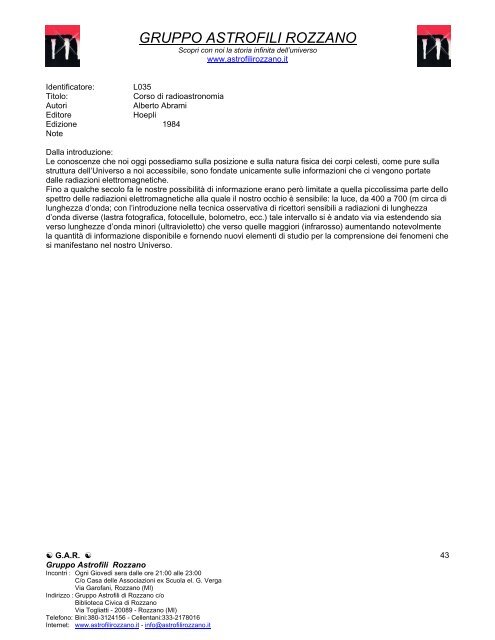[ GRUPPO ASTROFILI di ROZZANO [
[ GRUPPO ASTROFILI di ROZZANO [
[ GRUPPO ASTROFILI di ROZZANO [
Create successful ePaper yourself
Turn your PDF publications into a flip-book with our unique Google optimized e-Paper software.
Identificatore: L035<br />
Titolo: Corso <strong>di</strong> ra<strong>di</strong>oastronomia<br />
Autori Alberto Abrami<br />
E<strong>di</strong>tore Hoepli<br />
E<strong>di</strong>zione 1984<br />
Note<br />
☯ G.A.R. ☯<br />
Gruppo Astrofili Rozzano<br />
Incontri : Ogni Giovedì sera dalle ore 21:00 alle 23:00<br />
C/o Casa delle Associazioni ex Scuola el. G. Verga<br />
Via Garofani, Rozzano (MI)<br />
In<strong>di</strong>rizzo : Gruppo Astrofili <strong>di</strong> Rozzano c/o<br />
Biblioteca Civica <strong>di</strong> Rozzano<br />
Via Togliatti - 20089 - Rozzano (MI)<br />
Telefono: Bini:380-3124156 - Cellentani:333-2178016<br />
Internet: www.astrofilirozzano.it - info@astrofilirozzano.it<br />
<strong>GRUPPO</strong> <strong>ASTROFILI</strong> <strong>ROZZANO</strong><br />
Scopri con noi la storia infinita dell’universo<br />
www.astrofilirozzano.it<br />
Dalla introduzione:<br />
Le conoscenze che noi oggi posse<strong>di</strong>amo sulla posizione e sulla natura fisica dei corpi celesti, come pure sulla<br />
struttura dell’Universo a noi accessibile, sono fondate unicamente sulle informazioni che ci vengono portate<br />
dalle ra<strong>di</strong>azioni elettromagnetiche.<br />
Fino a qualche secolo fa le nostre possibilità <strong>di</strong> informazione erano però limitate a quella piccolissima parte dello<br />
spettro delle ra<strong>di</strong>azioni elettromagnetiche alla quale il nostro occhio è sensibile: la luce, da 400 a 700 (m circa <strong>di</strong><br />
lunghezza d’onda; con l’introduzione nella tecnica osservativa <strong>di</strong> ricettori sensibili a ra<strong>di</strong>azioni <strong>di</strong> lunghezza<br />
d’onda <strong>di</strong>verse (lastra fotografica, fotocellule, bolometro, ecc.) tale intervallo si è andato via via estendendo sia<br />
verso lunghezze d’onda minori (ultravioletto) che verso quelle maggiori (infrarosso) aumentando notevolmente<br />
la quantità <strong>di</strong> informazione <strong>di</strong>sponibile e fornendo nuovi elementi <strong>di</strong> stu<strong>di</strong>o per la comprensione dei fenomeni che<br />
si manifestano nel nostro Universo.<br />
43


